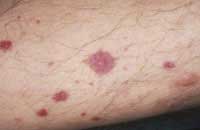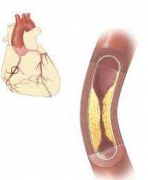What is system vasculitis? What are the types of systemic vasculitis? What are the causes and mechanism for the development of system vasculitis? Answers you will find in this article.
Content
Systemic vasculites - a generalizing generic name of a group of diseases in which several organs or body tissues are involved in a painful process. The basis of these diseases is the inflammatory damage to the wall of the blood vessels, which was reflected in the title: the word «Vasculit» Comes from Lat. Vasculum («vessel», «Vascidence») and Grech. -ITIS (suffix denoting inflammation). Synonymous words «Vasculit» are less frequently used terms «Angiit» (from Grech. angion - vessel) and «arteritis».
Types of systemic vasculitov
 From a practical point of view, the fact that vasculites are primary and secondary.
From a practical point of view, the fact that vasculites are primary and secondary.
Secondary vasculitis develops as an element of another disease and can be considered either as optional (optional), its manifestation, or as a complication. An example is many infectious diseases: Scarlatina, rapid typhoid, meningitis, sepsis, and skin diseases, such as psoriasis, etc. Sometimes vasculitis can be one of the manifestations of a malignant tumor of one or another organ; In this case, vasculitis will also be secondary, because after successful surgical, radiation or chemotherapeutic treatment of the tumor, the vaccine accompanying to it, as a rule, disappears without any special treatment.
Primary vasculitis are independent diseases relating primarily to the competence of rheumatologists, although the diagnosis and treatment of these diseases are impossible without the participation of doctors of other specialties: otolaryngologists, oculists, neuropathologists, dermatologists, etc. Inflammation of the wall of blood vessels - an integral line of these diseases, which is found in all without exception. The primary systemic vasculitis includes: Nonspecific AortoTarterite (synonyms: «Disease Suak», «Aorti arc syndrome»); Gigantaeer arteritis (synonyms: «Temple Arteritis», «Seenile arteritis», «Horton's disease»); nodule polyarteritis; Kawasaki disease; Vegener granulomatosis; microscopic polyangiite; Eosinophilic angiitis and granulomatosis (synonym: «Scorga-Strauss Syndrome»); cryoglobululmic vasculitis; Purple Shehenlein-Genoch (Synonym: «Hemorrhagic vasculitis»). With all the listed diseases, inflammation occurs in the wall of the vessels, however, the caliber of the affected blood vessels with different forms of vasculites of the neodynaks and varies from large arteries (1.0 cm diameter or more) to the smallest arterioles, capillaries and veins visible only under the microscope. Noodynaks and type of inflammation. All this explains the extremely pronounced manifold of clinical manifestations of primary systemic vasculitis and dissolving them on each other.
Causes and mechanism for the development of system vasculitis
The question is both the causes of the development of primary systemic vasculites. In the most general form, the mechanism of the occurrence of vasculitis is explained by immune dysfunction when the cells of the body's immune system and the aggressive substances produced by them begin to attack their own fabrics and organs. In turn, such dysfunction can cause different factors.
Of great importance are infections - both sharp and chronic, since in recent years it has been shown that some infectious agents are capable «deceive» Immune system, pervert immune response, redeparing it from microbial bodies on the internal structures of the body. At least with two systemic vasculites attributable to «Primary», - Nodule polyarteritis and cryoglobulinmic vasculite - the role of viruses is proved: respectively, the hepatitis B virus and hepatitis virus with. The foci of chronic bacterial (purulent) infection, especially chronic tonsillitis (recurrent angina) matter.
To other risk factors, potentially able to cause the development of vasculitis include abuse of drugs, the uncontrolled introduction of vaccines and sera, excessive passion «Zagar» And staying in the sun, prolonged supercooling. Sometimes role «Trigger hook» Physical injury, psycho-emotional overvoltage or alcohol use (sometimes even small doses of alcohol are unexpectedly capable of provoking the development of the disease).
Of course, the human body in normal conditions can easily confront all the types of influences; Therefore, it is assumed that vasculites are developing only as a result of the simultaneous combined effect of several factors, when the possibilities of adapting protective systems are exceeded.
Insolvency of protection systems can also be associated with the features of the inner hormonal status: some vasculites (for example, nonspecific aortoarterite of the ETASU and giantholecular arteritis) are more often developing in women, which is explained by the predisposing effect of high concentrations in the blood of estrogen - female sex hormones - causing imbalance in immune function systems; At the same time, other vasculitis (for example, a nodule polyarteritic), on the contrary, are more likely to hit men.
The scientific explanation of all these processes suffers from many numerous gaps and logical inconsistencies, much remains unclear and requires additional study. Not fully understood, for example, the role of the hereditary (genetic) predisposition to the development of systemic vasculitis: in several cases, the occurrence of vasculitis in the members of one family was noted; Some genes are identified that with more frequencies are found among the diseased system vasculites than among other persons. In the event that kidney transplantation is necessary for a patient with a systemic vasculitis, which caused severe kidney damage, undesirably to use the donor body obtained from close relatives, since genetic relationship increases the risk of recurrence of vasculitis in transplanted kidney. However, in the overwhelming majority of cases, vasculitis is not inherited from parents to children, and the risk of developing these diseases has a minimal.









